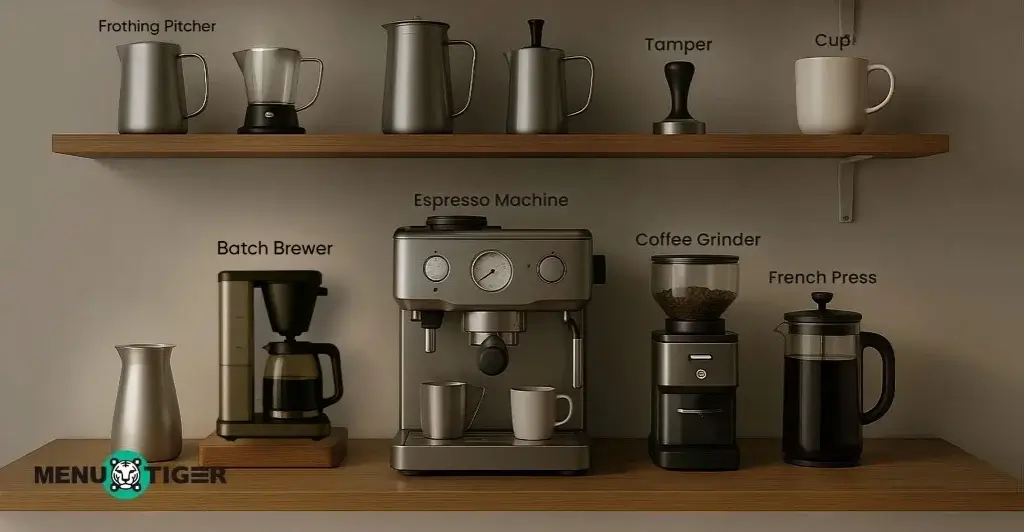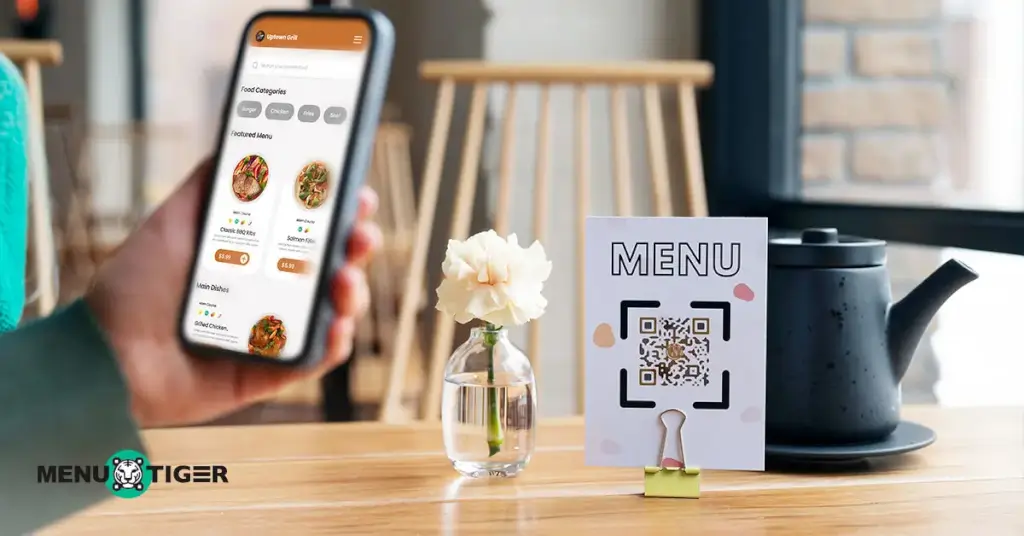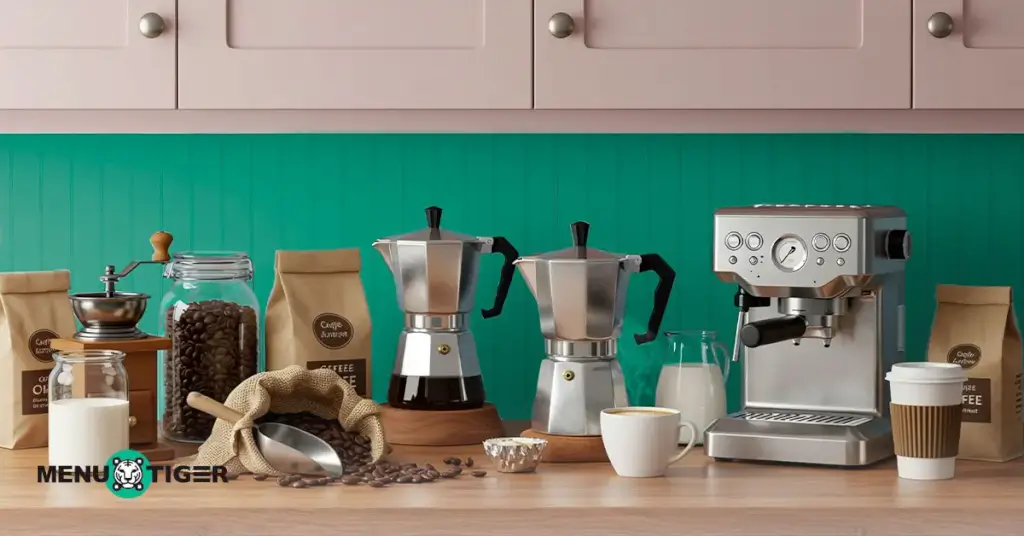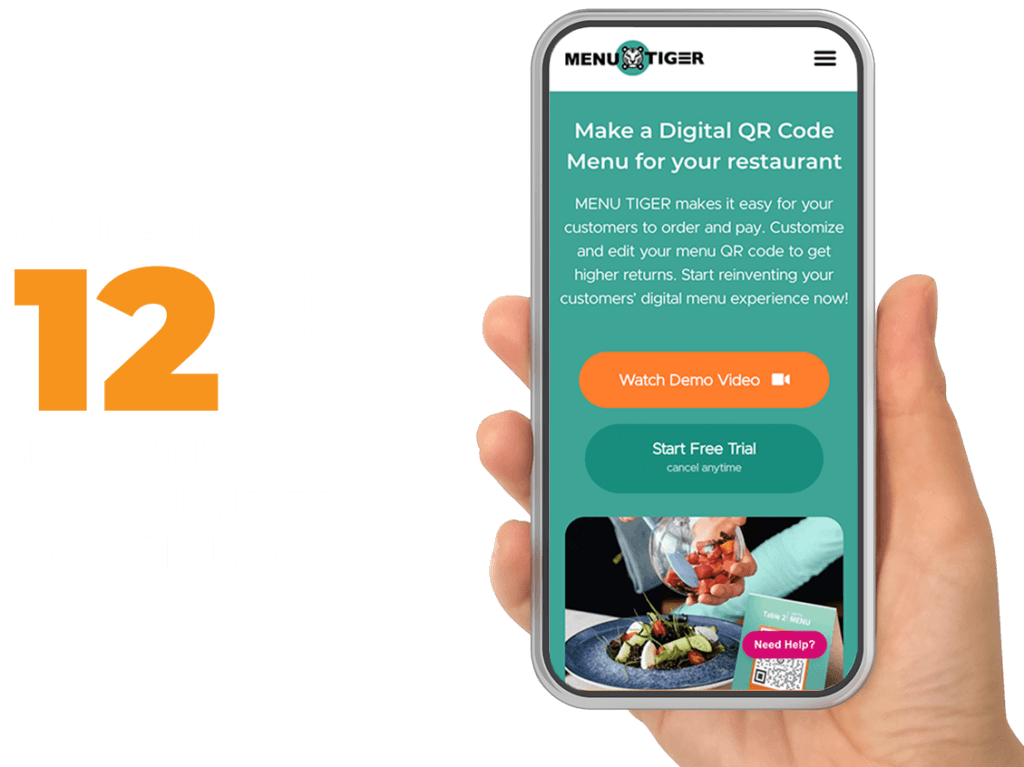As more people embrace their daily coffee rituals, the demand for good coffee keeps growing, and so does the profit potential. For aspiring café owners, that’s exciting, but it also means choosing the right coffee bar equipment can be challenging.
The coffee craze is not just hype either. According to the British Coffee Association, as cited by Investopedia, an estimated two billion cups of coffee are consumed every single day.
That demand might seem overwhelming, but choosing the right equipment doesn’t have to be complicated. Even something as simple as adding a QR code menu can help your café handle busy hours smoothly.
The good news is you do not have to figure it all out alone. This article will guide you through the essential equipment you need to run an efficient and successful café
Table of Contents
ToggleWhat equipment do you need for a coffee bar?

When setting up a café, choosing the right equipment can be just as challenging as coming up with the perfect cafe names for your coffee shop.
Below is a list of essential coffee bar equipment, covering both high-volume espresso tools and slow bar coffee equipment for manual, craft brewing that keeps your café running smoothly:
1. Brewing equipment
Espresso Machine – This uses high pressure to brew concentrated coffee in just a few seconds. This machine is essential for serving popular drinks like lattes and cappuccinos quickly and consistently during busy hours.
Coffee Grinder (Burr Type) – Producing even, consistent grinds, a burr grinder helps bring out the best flavor in every cup, which makes it a key tool for delivering quality across different brewing methods.
Batch Brewer – Brews large volumes of coffee quickly and consistently. Ideal for cafés and offices, it keeps high-quality coffee ready during peak hours and ensures smooth, efficient service.
Drip Coffee Maker – A convenient, budget-friendly machine designed for everyday use. It brews several cups of coffee with minimal effort, making it ideal for homes, small offices, or self-service setups.
While not built for heavy-duty use, it keeps coffee warm and ready for casual, low- to moderate-volume needs.
Pour-Over Coffee Maker (V60 or Chemex) – A favorite among coffee enthusiasts, this setup allows for manual brewing with precise control over flavor and strength, offering a more refined, handcrafted experience.
Pour-Over, Drip Coffee Maker, and Batch Brewer serves the same basic function: brewing filter coffee, but they differ in scale, control, and cost. It ultimately depends on what fits your workflow, service volume, and budget best.
French Press – The French press steeps coarse grounds in hot water before separating them with a plunger, making it a simple yet rich brewing option for customers who enjoy stronger brews.
Cold Brew Coffee Maker – This Steep grounds in cold water over several hours, this tool produces smooth, low-acid coffee that’s ready to serve chilled, perfect for meeting the growing demand for cold coffee options.
2. Beverage preparation tools
Milk Frother / Steam Wand – Smooth, foamy milk is what turns an ordinary coffee into a latte or cappuccino. This tool makes that possible by heating and texturing milk just right, giving each drink a creamy finish your customers will love.
Tamper – A good espresso starts with an even tamp. This small but mighty tool presses coffee grounds firmly into the portafilter, helping you pull consistent, balanced shots every time.
Blender – Icy, blended drinks like frappes and smoothies wouldn’t be possible without one. A strong blender handles everything from coffee and milk to syrups and ice, opening up your menu to refreshing, crowd-pleasing options.
Coffee Scales – Getting the right balance of coffee and water isn’t guesswork. A reliable scale ensures your measurements stay consistent, which means each cup tastes just the way it should.
Frothing Pitcher – Whether you’re steaming milk or pouring latte art, this pitcher gives you control. It helps you shape smooth textures and create clean, professional pours with ease.
Syrup Dispensers – When the line gets long, every second counts. These dispensers keep your flavored drinks consistent and your bar area neat by delivering just the right amount every time.
Shot Glasses / Measuring Cups – Measuring accurately makes a big difference, especially with espresso shots and milk. These tools help standardize your recipes and avoid guesswork behind the bar.
Thermometers (Milk & Water) – Burnt milk or off-temperature water can ruin a great drink. Thermometers give you peace of mind, making sure everything is just right before it reaches the customer.
3. Storage and cooling equipment
Refrigerator / Undercounter Fridge – This keeps your milk, syrups, and other perishables fresh and safe to use. It’s a must if you want to follow food safety standards and avoid spoilage during busy hours.
Ice Machine – A steady supply of ice is a game changer, especially when serving cold drinks. Whether it’s for iced coffee or frappes, having one on hand keeps service smooth and fast.
Water Filtration System – Clean water makes a big difference in both taste and equipment life. A good filtration system helps your drinks taste better and keeps your machines running longer.
Airtight Coffee Bean Containers – These help keep your beans fresh by protecting them from air, moisture, and light. Fresh beans mean better flavor, which your customers will notice.
Dry Storage Shelving – Staying organized is easier with sturdy shelving. It keeps your supplies in order and within reach, making your workspace cleaner and more efficient.
Milk Storage Jugs – These make handling milk quick and easy. They’re handy for refilling pitchers, keeping milk cold, and avoiding waste between rushes.

4. Cleaning and maintenance tools
Knock Box – Used coffee grounds pile up fast, and tossing them into a knock box makes cleanup quicker and keeps the counter tidy. It’s a simple tool that saves time during busy hours.
Cleaning Brushes – Espresso machines and grinders have small parts that collect residue over time. These brushes are designed to get into those tight spaces and keep everything running clean.
Descaling Solution / Tablets – Minerals from water can build up inside your machine and affect performance. Descaling products break that down, helping your equipment last longer and brew better-tasting coffee.
Cleaning Cloths / Towels – A set of dedicated cloths is essential for wiping steam wands, counters, and spills. Clean tools mean a clean bar, which your customers will notice.
Grinder Cleaning Brush – Coffee dust and oils can collect inside your grinder. A cleaning brush helps clear that out to keep your grind quality consistent and flavors from getting mixed.
5. Online menu ordering software and display equipment

POS System (Point of Sale) – A reliable POS system makes handling orders, tracking sales, and managing inventory much easier. It speeds up transactions and keeps operations organized, whether you run a small kiosk or a full café.
Cups & Lids Dispenser – Staying organized during the rush is much easier when cups and lids are neatly stored and easy to grab. A dispenser helps save counter space and speeds up drink prep.
Display Case – A clean, well-lit display case draws attention to pastries, sandwiches, or other snacks that can boost impulse purchases and add to your sales.
QR Code Menu – Adding a cafe ordering system like this gives customers a quick, contactless way to view your offerings. It makes updates simple, cuts down wait times, and adds a modern touch to your café experience.
6. Miscellaneous essentials
Fire Extinguisher – Safety should always come first. A fire extinguisher is a must-have for handling emergencies and complying with local safety regulations.
First Aid Kit – Accidents can happen anytime in a busy coffee shop. Having a first aid kit nearby ensures you’re ready to respond quickly to minor injuries or cuts.
Anti-Slip Floor Mats – Spills are unavoidable, but slips don’t have to be. These mats provide better traction behind the counter, helping prevent workplace accidents.
Trash Bins – A clean shop starts with proper waste management. Easily accessible bins encourage staff and customers to dispose of trash properly and keep your space tidy.
Wi-Fi Router – Reliable internet isn’t just a bonus anymore, it’s expected. A strong Wi-Fi connection supports your POS system and gives customers one more reason to stay longer.
How much does coffee bar equipment cost?

The cost of equipment of coffee bar depends on how you plan. Your plans can take into account coffee shop industry trends in 2025, as well as your business goals and budget.
To give you an idea of the total cost of the equipment, here’s some research on how much you can expect to spend overall:
- To give you an idea, Majesty Coffee, a trusted equipment supplier, estimates you’ll spend $80,000 to $300,000 to fully set up, depending on your café’s size and menu.
- Coffee Equipment Shop Miami, an online coffee gear retailer, shares a similar range of $80,000 to $300,000 covering equipment, renovations, and other startup costs.
- If you plan to roast your own beans, Scooter’s Coffee, citing Bellwether Coffee, says it can cost up to $150,000 with the equipment, plus setup and space for a total around $200,000, and about $5,000 more for brewers and grinders.
- According to Hotshot Coffee Sleeves, a company providing custom coffee sleeves, the cost for key equipment can range from $4,600 to $56,700.
There’s no one-size-fits-all cost for coffee bar equipment. It depends on your goals, the brands you choose, and how carefully you plan.
Should you invest in brand-new equipment or go secondhand?
A crucial point many first-timers in opening a coffee shop don’t realize is that choosing between brand-new and secondhand equipment isn’t just about the price tag, it can quietly shape your daily workflow, staff morale, and even how customers perceive your brand.
Secondhand equipment
Secondhand machines and gear can be a practical way to save money, especially when you’re just starting. Well-maintained used equipment can cost anywhere from 30% to 60% less than brand-new models.
Some cafés upgrade their equipment regularly, and it’s often possible to find quality pre-owned pieces through trusted resellers or reputable auctions.
Still, it’s important not to rush the process. Always inspect secondhand equipment intensively for signs of wear and tear, request its maintenance history, and test it thoroughly if possible.
Skipping these checks can lead to unexpected repair costs, downtime, extra expenses on your fixed coffee shop start up costs that can quickly wipe out any initial savings.
Brand new equipment
Brand-new equipment is more expensive upfront, but it comes with warranties, service support, and the latest features.
For some café owners, the peace of mind that comes with new equipment is worth the higher cost.
While secondhand equipment can save money upfront, brand-new equipment is often the better choice if you want reliability, long-term efficiency, energy-efficient, and fewer unexpected repairs.
On the downside, research has shown that the reason new businesses fail is lack of financing. Spending too much on brand-new gear at the start can put pressure on your cash flow.
If your café doesn’t generate enough sales right away, it can be harder to cover other expenses like rent, salaries, or marketing.
Final tip
Some café owners choose a mix: buying key items new (like an espresso machine) and picking up secondhand furniture or extra equipment to balance costs.
Another smart option is outsourcing certain tasks or services instead of handling everything in-house.
For instance, partnering with a local roaster instead of roasting your own beans, or leasing equipment instead of buying it outright.
This can help you control upfront costs and free up cash for other parts of your café.
Factors to consider before buying coffee shop equipment

Before you buy any equipment for your coffee shop, it’s important to think carefully about a few key factors that can save you money, time, and headaches later on.
1. Budget
Make sure your equipment costs leave enough room for other essentials like staff, rent, marketing, and unexpected expenses. Remember to factor in delivery, installation, and possible upgrades later so you don’t run out of cash when you need it most.
It’s important to consider your long-term budget and develop strategies that cover everything from initial expenses to the possibility of selling the business and legally avoiding capital gains tax on that transaction.
Think that you’re not just building a coffee shop, but a valuable asset for the future.
2. Space and coffee shop equipment layout
Measure carefully so your machines fit well and keep your workspace comfortable and efficient. Check doorways, counters, and ventilation. This helps your team move quickly and safely during rush hours.
3. Menu and capacity
Consider some cafe menu ideas and choose equipment that matches what you plan to serve and how many people you expect each day.
If you plan to expand your menu later, pick versatile machines that can handle new drinks or higher volume without needing a full upgrade.
4. Durability and maintenance
Pick gear that’s built to last, easy to clean, and has accessible spare parts. Well-built machines reduce breakdowns and downtime, while easy cleaning saves your staff time and keeps your drinks tasting great.
5. Warranty and support
Look for brands that offer good warranties and local support in case you need repairs fast. A solid warranty protects your investment, and having service technicians nearby means less downtime if something breaks unexpectedly.
What’s next after securing your coffee bar equipment?

Once you’ve got your equipment, make the most of it:
- Train staff to operate and clean machines correctly.
- Stick to a cleaning schedule to prevent breakdowns.
- Organize your space for a smooth workflow.
- Apply coffee shop marketing ideas and share your menu QR code.
- Deliver great service that keeps customers coming back.

Start your coffee business with the perfect equipment setup!
Investing in the right coffee bar equipment is just the beginning. To make your daily operations smooth and keep customers coming back, pair your setup with a clear, easy-to-update QR code menu that speeds up ordering and keeps lines moving.
Don’t leave your plans to chance, use this guide as your starting point to map out your must-have tools, budget wisely, and train your staff to get the most out of every machine.
Keep this list in mind, share it with your team, and start building a café that’s well-equipped, efficient, and ready to serve great coffee every single day.
FAQS
To make a good coffee, all you need is basic coffee equipment including an espresso machine, burr grinder, drip coffee maker, and slow bar coffee equipment like pour-over drippers or a French press. You’ll also need a milk frother, tamper, scale, and a water filter to keep coffee quality consistent.
A small coffee stand can work in 100–300 sq. ft., while a sit-down café usually needs 800–1,500 sq. ft. Make sure there’s enough space for equipment, staff movement, and customer flow.
A 5-bar coffee machine uses 5 bars of pressure to brew coffee. Commercial espresso machines usually use 9 bars to pull true espresso shots. A 5 bar machine makes strong coffee but may not produce classic espresso.





